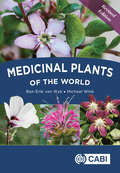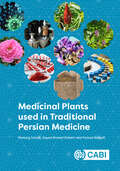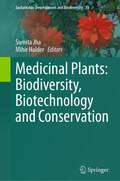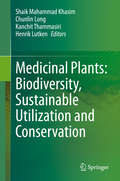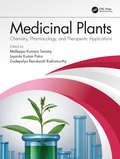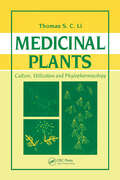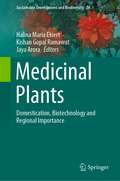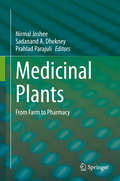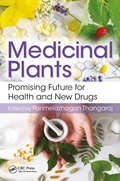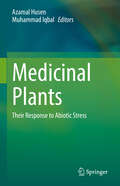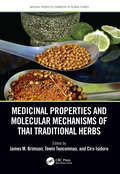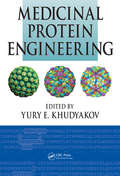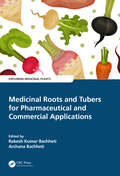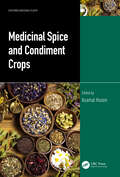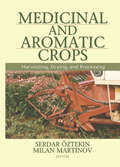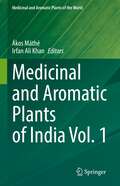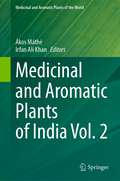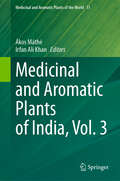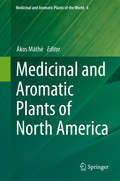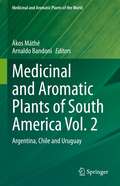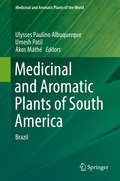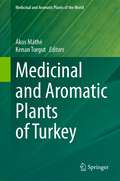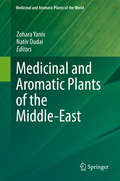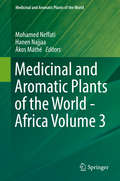- Table View
- List View
Medicinal Plants of the Asteraceae Family: Traditional Uses, Phytochemistry and Pharmacological Activities
by Tariq Aftab Hari Prasad DevkotaThis book highlights 12 major plants in the Asteraceae family from the aspects of traditional uses as food and medicine, phytochemistry, and pharmacological activities. Asteraceae is one of the largest family of flowering plants comprising over 1,600 plant genera and 32,000 plant species. Plants belonging to this family have a long history of being used as medicinal plants for the treatment of various diseases. Many of them are also used in the preparation of foods, beverages, and also used in pharmaceutical and cosmetic industries. In addition, plants such as Artemisia annua have played an important role in the discovery of novel drugs. The book summarizes the traditional uses of the plants in the family Asteraceae and their scientific validation, which helps readers understand their relation and impact on human health. It also explains the Phytochemistry of the species and presents the pharmacological activities and mechanisms in detail. Understanding current scientific knowledge will help in the commercialization of products based on these plants and also helps to find the research gaps that should be fulfilled in the future for their optimal use. It also helps in increasing the awareness of the plant species related to conservation, cultivation, and sustainable utilization. This edited volume comprises chapters contributed by experts from around the world.
Medicinal Plants of the World
by Ben-Erik van Wyk Professor Michael WinkMedicinal plants and plant-derived medicine are widely used in traditional cultures all over the world and they are becoming increasingly popular in modern society as natural alternatives to synthetic chemicals. As more and more natural remedies are being commercialised, there is a need for a user-friendly reference guide to the plants and their products. The book gives the reader a bird's eye view of more than 350 of the best known medicinal plants of the world and their uses, in a compact, colourful and scientifically accurate reference text. It provides quick answers to the most obvious questions: Where does this plant originate? What does it look like? In which culture is it traditionally used? What is it used for? Which chemical compounds does it contain? How safe is it? What is known about its pharmacological activity? What evidence is there that it is effective? The authors also provide short overviews of the various health conditions for which medicinal plants are used and the active compounds (secondary metabolites) found in the plants and their modes of actions. This new edition has an additional 30 plant species, many new and improved photographs and the text has been fully updated to reflect the latest regulatory status of each plant.
Medicinal Plants used in Traditional Persian Medicine
by Roja Rahimi Mamak Hashemi Abadi Maryam Akabery Seyyed Ahmad Askari Sayyedeh Fatemeh Askari Zahra Ayati Sajad Azad Parmis Badr Hamed Baharara Zahra Boghrati Mina Borhani Fatemeh Etemadpour Seyed Majid Ghazanfari Shakila Hajizadeh Bahia Namavar Jahromi Lida Jarahi Mohammad Reza Kanani Seyedeh Mahnaz Karimi Abdolali Mohagheghzadeh Leila Mohtashami Ghazaleh Mosleh Nayebzadeh Motahare Maryam Nikoosokhan Zahra Taghipour Mojgan Tansaz Meysam Zaeri Elaheh Zibaee Roodabeh Bahramsoltani Amir Hossein AbdolghaffariMedicinal plants and the natural products within them, still remain the starting point for breakthroughs in the development of safe, pharmacologically active synthetic molecules for use in a wide variety of clinical situations. Traditional Persian Medicine (TPM) is one of the most ancient medical doctrines, and is well-documented in terms of information about diseases, diagnoses and treatments, especially in the application of medicinal plants. TPM has been used for centuries worldwide, and many of these methods are still used in Iran today. The book introduces the basics of TPM, and describes the key medicinal plants used for the treatment of different diseases. It also highlights possible new targets for research activities in drug discovery of natural products. The book is richly illustrated with historic drawings from old Persian pharmacopoeia and photos of plants in their natural habitats. Reference to Ayurvedic, Traditional Chinese Medicine and monastic medicine in Europe are also made. While knowledge about medicinal plants used in TPM still exists in Iran there is a risk that the detailed expertise provided by older generations will be lost in the near future. It is therefore very important that this cultural heritage is properly preserved. This book provides a valuable, evidence-based resource on TPM for researchers, practitioners and students in medicinal plants, ethnobotany and herbal medicine.
Medicinal Plants: Biodiversity, Biotechnology and Conservation (Sustainable Development and Biodiversity)
by Sumita Jha Mihir HalderThis contributed volume provides a comprehensive, in-depth and subject-based reviews on the current status of active ingredients, sustainable use, biodiversity and conservation of certain endangered medicinal plants. The book also explores conventional and non-conventional biotechnological interventions for their biodiversity conservation. Medicinal plants have been used in worldwide as a major source of raw material for the traditional herbal healthcare practices as well as for drug discovery and development in pharmaceutical industry. The cumulative consequences of various human activities and environmental factors cause decline in the biodiversity of medicinal plants at an unprecedented rate worldwide. Thus, the overall understanding of ecology, species and genetic diversity along with assessment of the status of different threats and their impact on medicinal plants is crucial to sustain existing biodiversity, its utilization and conservation. All the latest advancements in the biotechnological approaches for the conservation research of endangered medicinal plants and the future perspectives have been described. This book provides comprehensive reviews spreading over about 25 chapters divided in three sections. The chapters of this book are written by recognized scientists in their respective fields which are useful to students, academicians, researchers, botanists, biotechnologists, policy makers, conservationists and industries interested in biodiversity conservation and medicinal plant research for the production of secondary metabolites.
Medicinal Plants: Biodiversity, Sustainable Utilization and Conservation
by Shaik Mahammad Khasim Kanchit Thammasiri Chunlin Long Henrik LutkenPlants have been a source of medicines and have played crucial role for human health. Despite tremendous advances in the field of synthetic drugs and antibiotics, plants continue to play a vital role in modern as well as traditional medicine across the globe. In even today, one-third of the world’s population depends on traditional medicine because of its safety features and ability to effectively cure diseases. This book presents a comprehensive guide to medicinal plants, their utility, diversity and conversation, as well as biotechnology. It is divided into four main sections, covering all aspects of research in medicinal plants: biodiversity and conservation; ethnobotany and ethnomedicine; bioactive compounds from plants and microbes; and biotechnology. All sections cover the latest advances. The book offers a valuable asset for researchers and graduate students of biotechnology, botany, microbiology and the pharmaceutical sciences. It is an equally important resource for doctors (especially those engaged in Ayurveda and allopathy); the pharmaceutical industry (for drug design and synthesis); and the agricultural sciences.
Medicinal Plants: Chemistry, Pharmacology, and Therapeutic Applications
by Jayanta Kumar Patra Mallappa Kumara Swamy Gudepalya Renukaiah RudramurthyThis book details several important medicinal plants, their occurrence, plant compounds and their chemical structures, and pharmacological properties against various human diseases. It also gives information on isolation and structural elucidation of phytocompounds, bio-assays, metabolomic studies, and therapeutical applications of plant compounds.
Medicinal Plants: Culture, Utilization and Phytopharmacology
by Thomas S. LiMedicinal Plants: Culture, Utilization and Phytopharmacology covers over 400 species. Each chapter gathers valuable information from a wide variety of sources, and supplies it to the user in convenient table format, arranged alphabetically by scientific name, followed by the common name. Data topics include: major constituents (active ingredients)
Medicinal Plants: Domestication, Biotechnology and Regional Importance (Sustainable Development and Biodiversity #28)
by Kishan Gopal Ramawat Halina Maria Ekiert Jaya AroraMedicinal plant research is an evergreen subject. There is a tremendous increase in popularity of herbal medicine in traditional medicine, ethnomedicine, modern medicine and as over the counter food supplements. Even after this increased demand, supply is neither uniform nor assured as most of these plants are collected from wild. In developing countries of tropical and subtropical regions where majority of herbal drugs are produced, this is not organised sector making it vulnerable to several malpractices, hence standardization of all aspects required. This has also negative impact on biodiversity and conservation of plants as well as supply of uniform material. This book is aimed to provide up to date information about sustainable use of selected medicinal plants, their active ingredients and efforts made to domesticate them to ensured uniform supply. Development of agrotechnology, biotechnology and cultivation practices using conventional and non-conventional methods are presented. Where these efforts will lead the medicinal plant research and future perspective are discussed. The chapters are written by well recognised group leaders in working in the field. The book contains topics on general biology of medicinal plants, their sustainable use and, cultivation and domestication efforts. A uniform chapter structure has been designed to keep consistency. The book will be useful for academicians, agriculturists, biotechnologists and researcher, and industries involved in manufacturing herbal drugs and supplementary products.
Medicinal Plants: From Farm to Pharmacy
by Nirmal Joshee Sadanand A. Dhekney Prahlad ParajuliThis book offers a fresh look on a variety of issues concerning herbal medicine - the methods of growing and harvesting various medicinal plants; their phytochemical content; medicinal usage; regulatory issues; and mechanism of action against myriad of human and animal ailments. ‘Medicinal Plants: From Farm to Pharmacy’ comprises chapters authored by renowned experts from academics and industry from all over the world. It provides timely, in-depth study/analysis of medicinal plants that are already available in the market as supplements or drug components, while also introducing several traditional herbs with potential medicinal applications from various regions of the world. The book caters to the needs of a diverse group of readers: plant growers, who are looking for ways to enhance the value of their crops by increasing phytochemical content of plant products; biomedical scientists who are studying newer applications for crude herbal extracts or isolated phytochemicals; clinicians and pharmacologists who are studying interactions of herbal compounds with conventional treatment modalities; entrepreneurs who are navigating ways to bring novel herbal supplements to the market; and finally, natural medicine enthusiasts and end-users who want to learn how herbal compounds are produced in nature, how do they work and how are they used in traditional or modern medicine for various disease indications.
Medicinal Plants: Promising Future for Health and New Drugs
by Parimelazhagan ThangarajThis book highlights the importance of traditional medicines, focuses on the standardization of herbal medicine and evaluates opportunities for advancing drug research. It addresses issues in utilization of medicinal plants and shares the importance of herbs in neutraceutics. It provides most competitive techniques being used in research.
Medicinal Plants: Their Response to Abiotic Stress
by Muhammad Iqbal Azamal HusenThis book provides a comprehensive overview of medicinal plants and their interaction with abiotic stress in terms of morphological, physiological, biochemical, and molecular variations, and explains the adaptation and tolerance mechanisms involved. It presents various mechanisms that become operative in medicinal plants to combat stressful situations. The book discusses the secondary metabolites and/or bioactive compounds produced in medicinal plants under abiotic stress conditions, and the use of biostimulants and/or phytoprotectants to alleviate the adverse effects of abiotic stresses on medicinal plants. Additionally, it is likely to address opportunities and challenges in molecular and omics studies of medicinal plants under abiotic stress conditions. Overall, the chapters are developed by eminent subject experts with due care and clarity and cover an up-to-date literature review with relevant illustrations. The book would cater to the need of graduate and post-graduate students, researchers as well as scientists, and may attract the attention of pharmaceutical companies/industrialists and health policymakers.
Medicinal Properties and Molecular Mechanisms of Thai Traditional Herbs (Natural Products Chemistry of Global Plants)
by James M. Brimson, Tewin Tencomnao, and Ciro IsidoroWith a focus on the unique cultural and ecological of aspects of Thailand, this latest title in the popular series, Natural Products Chemistry of Global Plants, offers invaluable insights for researchers and healthcare professionals interested in exploring the potential of Thai herbal medicines in the broader context of global health and wellness. It also appeals to individuals seeking natural and traditional alternatives to modern medicine. The book provides a bridge between modern pharmacology and traditional medicinal practices, thereby bringing Thai traditional herbal medicines into the mainstream, while giving a critical explanation of their efficacy and safety.
Medicinal Protein Engineering
by Yury E. KhudyakovAn All-Inclusive Review of the Achievements and Trends in the Fast-Growing Protein Engineering Field From humble beginnings like making fire for mere survival, engineering now steadfastly penetrates all aspects of our lives and even life itself at the molecular level. Protein engineering is a molecular biological discipline focused on designing and
Medicinal Roots and Tubers for Pharmaceutical and Commercial Applications (Exploring Medicinal Plants)
by Rakesh Kumar Bachheti and Archana BachhetiThe root and tuber are vital parts of medicinal plants providing mechanical support, producing critical growth regulators, and storing food. Bioactive compounds obtained from plant roots and tubers demonstrate health benefits presenting antioxidative, antimicrobial, hypoglycaemic, hypocholesterolaemic, and immunomodulatory properties. Roots of many medicinal plants have been used for the treatment of disease and formulation of drugs, and they are also known for their commercial value, being used as an ingredient in the pharmaceutical and cosmetic industries. Medicinal Roots and Tubers for Pharmaceutical and Commercial Applications provides information on the medicinal properties of roots and tubers and various phytochemicals derived from them. Features Presents exhaustive information on plant roots and tubers including Glycyrrhiza glabra, Curcuma longa, Beta vulgaris, Zingiber officinalis, Boesenbergia pandurata, Houttuynia cordata, Eutrema japonicum, and Withania somnifera Explains the roles of secondary metabolites isolated from roots and tubers and features information on their pharmaceutical and commercial applications Discusses opportunities for future prospects of different roots and tubers for their industrial applications A volume in the Exploring Medicinal Plants series, this book provides information on phytochemicals derived from medicinal plant roots and tubers. This is valuable information for scientists, researchers, and students working on medicinal plants, economic botany, chemistry, biotechnology, pharmaceuticals, and many other interdisciplinary subjects.
Medicinal Spice and Condiment Crops (Exploring Medicinal Plants)
by Azamal HusenSpices are used in small quantities to add flavor, aroma, color, and texture in food preparation. However, spices and condiments have also been recognized as having medicinal value. They have been used traditionally as curative and preventive agents, the bioactive compounds obtained from these plants are used in herbal drug formulations in modern times. Medicinal Spice and Condiment Crops provides a comprehensive overview on the medicinal properties of spices and condiments with focus on various phytochemicals derived from them.KEY FEATURES:• Examines spices and condiments with respect to their biology, diversity, distribution, and pharmacological values.• Explores the scientific validations of the therapeutic potentials of spice and condiment plant species.• Discusses the bioactive agents involved in alleviating symptoms of cardiovascular disease, cancer, diabetes, ulcers, skin disorders, and neurodegenerative diseases.• Explains specific medicinal features of spice and condiment-producing plant species inspiring research, discovery, and safe herbal drug formulation.A volume in the Exploring Medicinal Plants series, this book is useful for plant scientists, economic botanists, those who work with herbal and complementary medicine, as well as people working in the pharmaceutical industry.
Medicinal and Aromatic Crops: Harvesting, Drying, and Processing
by Serdar Oztekin Milan MartinovMake sure your crops are market-ready with the aid of harvest and post-harvest mechanization Medicinal and Aromatic Crops presents harvest and post-harvest mechanization methods for the profitable production of market-ready medicinal crops. This practical handbook includes photos, detailed figures, and schematic drawings of machines tha
Medicinal and Aromatic Plants of India Vol. 1 (Medicinal and Aromatic Plants of the World #8)
by Ákos Máthé Irfan Ali KhanThis book is the 8th volume of the popular series ‘Medicinal and Aromatic Plants of the World’. Like the previous volumes, this volume is being introduced in a monographic format containing an extremely rich and diverse medicinal flora of India. Both well-known and somewhat still ignored species have been described in view of their traditional, present day and prospective uses. The scientific and technological achievements are also included aptly in this volume, together with a careful and critical consideration to our contemporary knowledge of this vast interdisciplinary domain with an Indian focus. In the era of global climate change and pandemics, building on the huge Indian traditions, this volume will make an important contribution to the better knowledge and understanding of MAPs. The Indian flora has always been recognized for its medicinal and aromatic plant values and this volume is explicitly focusing in that direction. With the rapidly expanding scope of natural nutraceuticals and herbal formulations, this book will be a fruitful acquisition for the interested readers globally.
Medicinal and Aromatic Plants of India Vol. 2 (Medicinal and Aromatic Plants of the World #9)
by Ákos Máthé Irfan Ali KhanThis book is the 9th volume in the series Medicinal and Aromatic Plants of the World. India being one of the countries with the longest and richest past/present/future of Medicinal and Aromatic Plant (MAP) production and utilization has accumulated more than sufficient knowledge to fill two volumes. This is shown by the vivid interest of Indian colleagues to contribute. Similar to the previous volumes, this one deals with the various important aspects (from botanical through phytochemical to pharmacological) of MAPs', famous or simply known of India. Scientific and technological achievements will be equally presented.In addition to the first volume, India V1, this volume is aimed to look carefully at our present knowledge of this vas interdisciplinary domain with an Indian focus. In the era of global climate change and pandemics, building on the huge Indian traditions, this book is expected to make an important contribution to the better knowledge and understanding of MAPs.
Medicinal and Aromatic Plants of India, Vol. 3 (Medicinal and Aromatic Plants of the World #11)
by Ákos Máthé Irfan Ali KhanThis book is the 11th volume of the popular series "Medicinal and Aromatic Plants of the World". It is a comprehensive compilation of 30 chapters on selected important species representative of India's rich and diverse flora. This collection provides current scientific information highlighting the traditional, contemporary, and prospective uses of both well-known and lesser-known plant species. The volume serves as a bridge between traditional knowledge and modern scientific advancements, providing a critical analysis of this broad interdisciplinary field with a particular focus on India. The chapters cover topics such as the pharmacological properties, biochemical composition, and therapeutic applications of these plants. Readers will find contributions by renowned scholars who delve into the innovative product development stemming from the ancient medicinal plant systems. Particular attention is given to how these plants can contribute to health and wellness in the era of global climate change and pandemics. This book invites readers to face critical questions about the survival and utilization of medicinal and aromatic plants in India. Researchers, scholars, and practitioners in fields of botany, pharmacology, and traditional medicine will find this volume invaluable. It is also an essential resource for anyone interested in botanicals, plant-based nutraceuticals and herbal formulations. Whether you are an academic or a professional working in the field of medicinal plants, this book offers a wealth of knowledge that bridges rich ancient traditions with modern science.
Medicinal and Aromatic Plants of North America (Medicinal and Aromatic Plants of the World #6)
by Ákos MáthéThis volume is aimed at offering an insight into the present knowledge of the vast domain of Medicinal and Aromatic Plants with a focus on North America. In this era of global climate change the volume is meant to provide an important contribution to a better understanding of the diverse world of Medicinal and Aromatic Plant research, production and utilization.
Medicinal and Aromatic Plants of South America Vol. 2: Argentina, Chile and Uruguay (Medicinal and Aromatic Plants of the World #7)
by Ákos Máthé Arnaldo BandoniThis volume, as the seventh of the series Medicinal and Aromatic Plants of the World, deals with the medicinal and aromatic plant (MAPs) treasures of the so-called Southern Cone, the three southernmost countries (Argentina, Chile and Uruguay) of South America. Similarly to the previous volumes of the series, the main focus is to collect and provide information on major aspects of botany, traditional usage, chemistry, production / collection practices, trade and utilization of this specific group of plants. The contributors, who are recognized professionals and specialist of the domain, have collected and present state of the art information on 41 species. Most of these are not only of interest from the scientific point of view, but hold also a potential for the prospective utilization of the decreasing, occasionally overexploited / endangered medicinal plant resources of this huge continent. The book is expected to serve as a source of information also on some less known or less studied species. As such the volume is expected to support future research and public health professionals.
Medicinal and Aromatic Plants of South America: Brazil (Medicinal and Aromatic Plants of the World #5)
by Ulysses Paulino Albuquerque Ákos Máthé Umesh PatilThis volume in the series deals with the major Medicinal and Aromatic Plants (MAPs) of South America, providing information on major aspects of this specific group of plants on that continent (botany, traditional usage, chemistry, production/collection practices, trade and utilization). Brazil, in particular, offers an immense amount of biodiversity, including plants with great pharmacological interest and ethno-medicinal importance. Contributions are from internationally recognized professionals, specialists of the Medicinal and Aromatic Plant domain and have been invited mostly from the members of the International Society for Horticultural Science and International Council for Medicinal and Aromatic Plants.
Medicinal and Aromatic Plants of Turkey (Medicinal and Aromatic Plants of the World #10)
by Ákos Máthé Kenan TurgutThis is meant to be the 10th volume of the series Medicinal and Aromatic Plants of the World. Similarly, to the previous volumes, the work will deal -in a monographic form- with MAPs characteristic/famous or simply known of Turkey, a large country that is connecting Europe with Asia. Turkey has extremely rich and varied topographic/ecologic conditions. As a result, the flora of Turkey abounds in an astonishingly great number of endemic MAP species. Traditional, present and possible prospective uses will be discussed. Scientific and technological achievements will be equally presented. Briefly, the volume is aimed to look carefully at our present knowledge of this vast interdisciplinary domain of medicinal and aromatic plants with a focus on Turkey. In the era of global climate change and Covid-pandemics, building on the huge Turkish traditions, the proposed volume of the series is expected to make an important contribution to the better knowledge and understanding of the MAP wealth of the World.
Medicinal and Aromatic Plants of the Middle-East
by Nativ Dudai Zohara YanivThe current volume, "Medicinal and Aromatic Plants of the Middle-East" brings together chapters on selected, unique medicinal plants of this region, known to man since biblical times. Written by leading researchers and scientists, this volume covers both domesticated crops and wild plants with great potential for cultivation. Some of these plants are well-known medicinally, such as opium poppy and khat, while others such as apharsemon and citron have both ritual and medicinal uses. All have specific and valuable uses in modern society. As such, it is an important contribution to the growing field of medicinal and aromatic plants. This volume is intended to bring the latest research to the attention of the broad range of botanists, ethnopharmacists, biochemists, plant and animal physiologists and others who will benefit from the information gathered therein. Plants know no political boundaries, and bringing specific folklore to general medical awareness can only be for the benefit of all.
Medicinal and Aromatic Plants of the World - Africa Volume 3
by Ákos Máthé Mohamed Neffati Hanen NajjaaThis volume in the series is devoted to Africa, a continent that possesses a vast treasure of medicinal plants and has produced some exclusive materials for the world market. This volume is expected to strengthen the medicinal plant sector in African countries by making comprehensive information on medicinal and aromatic plants available to policy-makers and entrepreneurs. It can be used to frame effective policies and create an environment conducive to the growth of the plant-based medicine industry, bringing economic benefit to African nations. It will help health organizations to improve the health of their people by using their own resources and a less expensive system of medicine, which is accepted by African society. It could also lead scientific communities to increase R&D activities in the field.

